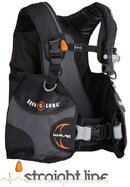Lots of good positive criticism, only thing I will add is get a necklace to hold your octopus under your chin, I think that is what TS&M is also referring too about using a bungeed octo.
This idea isn't bad but you can't just do that with a standard configuration. If you want your octopus on a necklace then your kit needs to be configured with a long(er) hose on the main as well. (and don't forget to practice with it because the hand-off protocol is different!)
===
Also, I agree in part with what Lynne (TSandM) says, which is that "octopus holders" -- ie, actual little clips etc that are intended to hold your octopus in place -- are universally crap with an unacceptable potential to either let go of the octopus when you don't want or to hold it too tightly when you need to get it loose.
However, there is at least one alternative without re-kitting everything. Aqualung have (finally) designed a BCD with some actual thought put into it, called the "wave". At the bottom of this post is a picture of it where you can clearly see an opening on the top corner of the pocket beside the D-ring. That opening is designed specifically to stow the octopus. It's easy to get the octopus in, it's easy to get it out, it is streamlined and the position of the octopus is both unobtrusive and easy to deploy for both the diver using the BCD and his/her buddy.
In other words, it's perfect, and as far as my limited knowledge goes, the only jacket I know of with a 100% perfect system for holding the octopus. Why every jacket on the market doesn't have this is completely beyond me.
And the best part? It's their cheapest but best designed BCD. You gotta like that. When it comes to BCD design, less is definitely more!
R..






